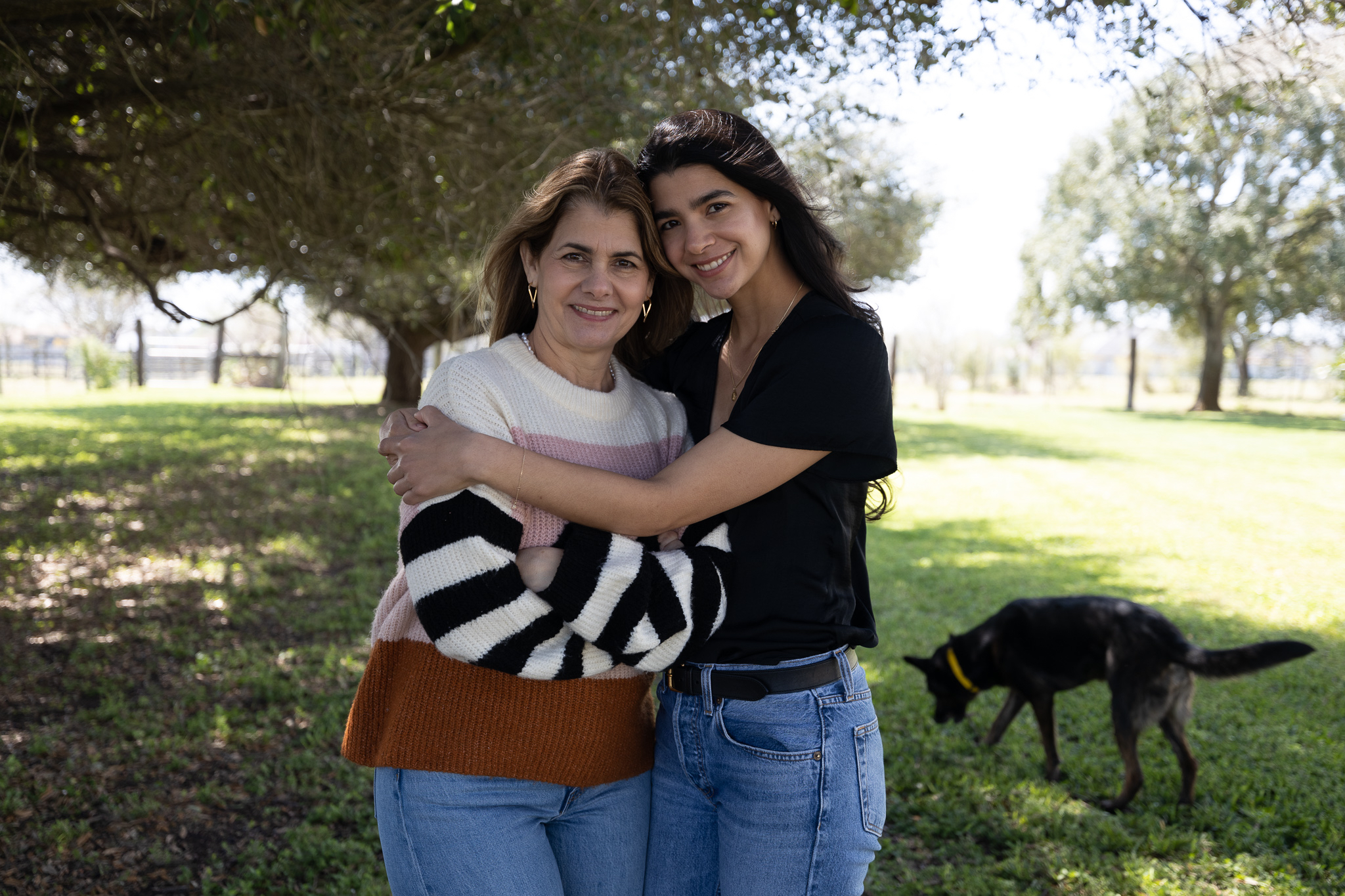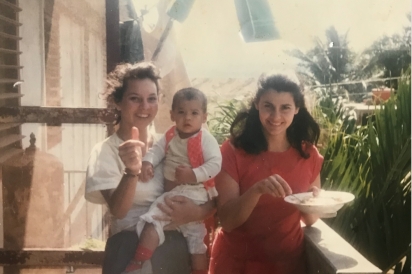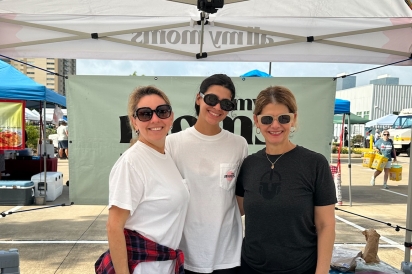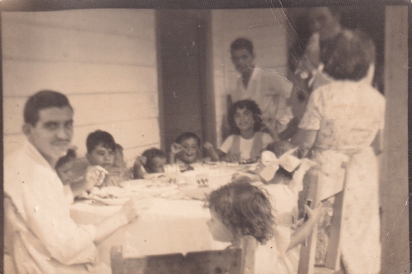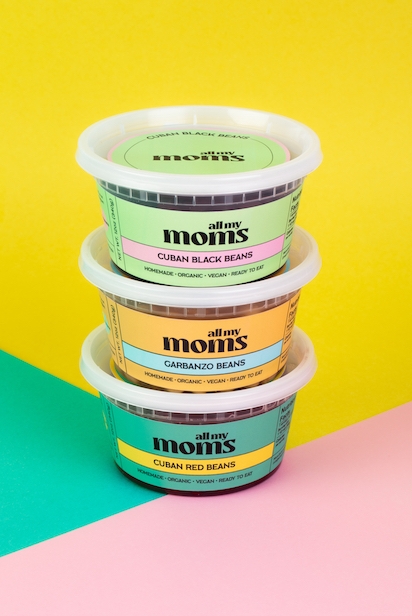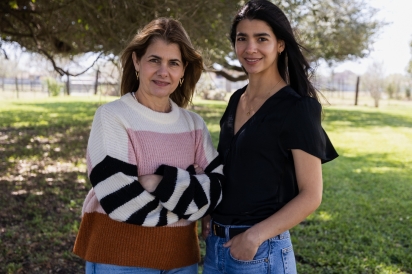Comida Criolla
Alexandra Quintana, co-founder of Cuban food purveyor All My Moms, has two photos that capture the essence of her business. “One is a picture of my aunt and my mom carrying me, feeding me food. And now, fast-forward, a picture of us at the farmers market, my mom, and my aunt, and me in the middle,” she says.
The farmers market, specifically the Urban Harvest Farmers Market, is where I first met Quintana. She was standing under a white tent in front of a pastel green banner with a pale pink sunburst highlighting the company’s social media handle — colors inspired by her grandmother’s house in Cuba. It’s not just the branding that is inspired by her ancestors. Most weekends, Quintana is enthusiastically selling Cuban food that is “an ode to all the women who helped raise me…my mom, my grandmother, my aunt, even neighbors.”
For now, that food is focused on the humble, nourishing, yet multidimensional dishes her mom and business partner, Gladita Avila, cooked when Quintana was growing up: Cuban black beans, Cuban red beans, garbanzo beans, lentils and rice, rice pudding and congrí (a Cuban black bean and rice dish often served at celebrations).
Quintana was born in Cuba and grew up during the 1990s in Bahía Honda, a rural town on the northwest coast of the island, located on the Straits of Florida roughly halfway between Miami and Cancún. It was a difficult time on the island. The Soviet Union, Cuba’s main trade partner and financial supporter, had fallen early in the decade, leaving the country isolated, economically devastated and with little food or fuel. “When I was growing up, after the fall of the Soviet Union, there was nothing … the protein that I grew up on was mainly beans,” says Quintana.
This scarcity has reshaped Cuban cuisine. “Because of the economic situation, I think that the essence of Cuban food has lost a lot on the island itself,” says Quintana. It’s a sentiment echoed by Cuban-American filmmaker Asori Soto in his award-winning documentary Cuban Food Stories. He notes that during the post-Soviet-era beef was replaced by soybeans and cooking oil was replaced by water and that Cubans have been poor for so long they have lost many of their culinary traditions.
Despite the shortages, food and hospitality were still central to Quintana’s family life in rural Cuba. There was the occasional, celebratory pig roast using pigs they raised themselves. But more often, Quintana says, “We grew up eating whatever was in the backyard,” which included guava, mangoes, papayas, carrots and cabbage. Sharing what food they had was important to her family, even when they didn’t have enough. “My aunt used to say whenever people were over, ‘Oh my god, what are we going to feed them? Just add water to the soup.’ We would just keep adding water to the soup and keep feeding people,” Quintana says.
Twenty years ago, when Quintana was 11, she and her mom left Cuba because of the ongoing dire economic situation and the years of living under the oppressive Castro regime, which had denied Avila the opportunity to become a nurse because she wouldn’t renounce her religion. They lived in Miami for a few years before moving to south Texas where they had family.
For Quintana, arriving in South Texas, which has a deeply-rooted Mexican culture, caused an even bigger culture shock than moving to Miami, which is home to many Cubans. She learned that “even if you speak the same language, even if you were conquered by the Spanish, cultures are so different; the food is different.” The Mexican food she encountered in Texas was spicier than Cuban food and some words had different meanings. When a young cousin was born, her mother asked a nurse for a “culero,” which means diaper in Cuban Spanish. The nurse thought she was being insulted because that word is an insult in Mexico. Another time, her mother ordered a “tortilla” at a restaurant and was surprised when she was brought a corn tortilla. She had expected a potato omelet. “Corn tortillas don’t exist in Cuba. We had never seen them,” says Quintana.
Eventually, Quintana’s family moved to Houston, and she attended college in Boston. After returning to the Bayou City, her grandmother unexpectedly passed away shortly before Quintana’s birthday. While she was cleaning out her grandmother’s refrigerator, she found all the ingredients to make a traditional pig’s feet stew — the dish she always asked her grandmother to make for her birthday.
“I had been dealing with that sense of loss and thought ‘No one is ever going to be able to taste my grandma’s food ever again. I don’t want that to be the case for my mom," Quintana says. That realization is why she started All My Moms. She wanted to share the food of her mom, her grandmother, her aunts and of her homeland.
That food she says is “very humble. It’s an unassuming food, but it’s not basic. It has a synchronization of so many flavors.” It primarily blends influences from Spain with those of the enslaved West Africans who were forced to Cuba by the Spanish. These confluences of cuisines are reflected in such dishes as the aforementioned pig’s feet stew and okra stew, which Quintana notes are heavily derived from West African cuisine. As is another popular Cuban stew, ajiaco.
“It’s one of my favorite things,” says Quintana. “And if there's one dish that showcases the essence of everything that has happened in Cuba since 1492, it's ajiaco.” According to Quintana, the dish usually combines different root vegetables such as cassava, ñame (yam) and malanga, which are from West Africa; meats, including cured meats if available, which show Spanish contributions; and vegetables such as squash, which reveal the influence of Indigenous people like the Taíno. “It’s literally a melting pot,” she says.
Another important influence on Cuban cuisine were the Chinese workers who built the island’s railroads. They introduced their flavors and their white rice, which is now a significant part of Cuban foodways and features in All My Moms’ offerings such as congrí, lentils and rice, and rice pudding.
These culinary influences, along with essential ingredients such as cumin, garlic, culantro, sugar and bitter orange (“a holy grail of Cuban food because it is used to season pork”), are at the heart of comida criolla, which Quintana describes as “the original Cuban food, the one that incorporates West African, Spanish and Native American.
To enjoy Quintana and Avila’s version of comida criolla — a version rooted in rural Cuba, a love of family and a refrigerator stocked with all the ingredients for pig’s feet stew — look for the All My Mom’s products at the Urban Harvest, Rice Village, and Heights Mercantile Farmers Markets, and Central City Co-op. “It’s the food we’ve been cooking to nourish our family for generations,” says Quintana.
Learn more at allmymoms.com and @allmymoms on Instagram.
About the Contributor
David Leftwich is editor of Edible Houston and loves to cook locally grown vegetables and hang out with his daughter, wife and a few too many stacks of books.


